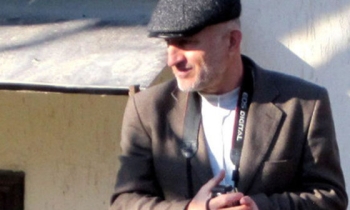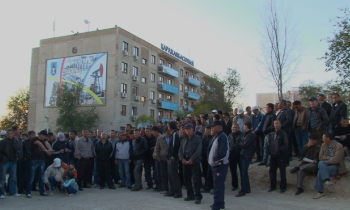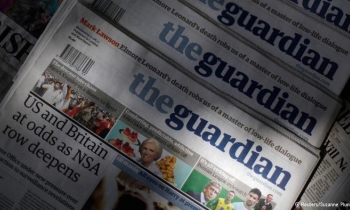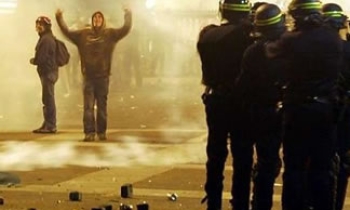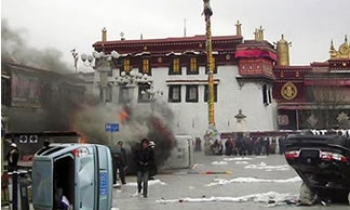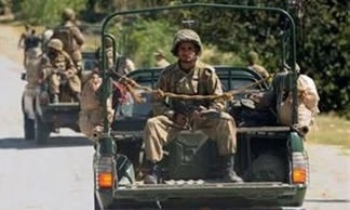Press freedom worldwide is deteriorating, with 38 journalists murdered in the past six months and increasing pressure on freedom of expression in many countries, according to the annual half-year review of press freedom by the World Association of Newspapers (WAN).
The report, presented Saturday to the Board of the Paris-based WAN on the eve of the World Newspaper Congress and World Editors Forum in Moscow, Russia, painted a picture of attacks, imprisonment and murder facing journalists in many countries.
"In the past six months, journalists worldwide have once again been the victims of harassment, physical violence and murder. A record number of journalists were arrested and imprisoned in Nepal, Belarus, and Ethiopia. Dozens more remain in prison in China, Cuba and Eritrea. Media enterprises throughout the world have been destroyed or forced to close," WAN said.
Thirty-eight journalists have been killed since November 2005. But that number could be even higher – press freedom monitors report that journalists are censoring themselves rather than risk their lives in Colombia and the Philippines, two of the world's most dangerous countries for journalists, where murderers operate with impunity. Seven journalists have been killed in the Philippines and one in Colombia in the past six months.
Administrative and legal harassment of publications account for the greatest number of press freedom abuses in Europe and Central Asia. More journalists are arrested an in jail in Asia than in any other region. Repressive governments mark the Middle East and North Africa region. Imprisoned journalists in Cuba and the willingness of American Internet companies to place profit ahead of principle define the Americas. In Africa, the continued clampdown on independent media in Zimbabwe is added to the already numerous crippling challenges media on the continent have to contend with.
THE AMERICAS
Journalists killed = Colombia (1), Ecuador (2), Guyana (1), Mexico (1), Venezuela (1)
With more than 20 journalists behind bars in Cuba and the murder of journalists in five different countries, the Americas have suffered a number of setbacks in press freedom in the past six months.
Cuba, with a staggering 24 journalists remaining in prison, is the hemisphere's – and indeed one of the world's – most notorious jailors of journalists. Twenty-three of the journalists currently in prison were victims of the March 2003 crackdown on the press. Many of them have developed serious health problems, creating cause for increased concern over their general well being.
Mario Enrique Mayo, a journalist and lawyer serving a 20-year sentence, cut his own face, stomach, and limbs with a homemade knife in an attempt to demand his release. He twice attempted suicide while behind bars. The journalist was granted special medical release from prison in December 2005. In March, Lamasiel Gutierrez Romero, jailed for her refusal to stop working as an independent journalist, received conditional release from prison. Gutierrez Romero holds the dubious title of being the first female journalist behind bars in the country.
In recent months, foreign journalists have also been targets of harassment in Cuba. Anna Bikont, a reporter for the Polish newspaper Gazeta Wyborcza, and Swiss journalist Nelly Norton were detained and forced to leave the country in December. The journalists had entered Cuba with tourist visas and were arrested in the city of Sancti Spiritus after interviewing dissidents. All of the notes and photographs they had taken during their visit were confiscated.
The current political chaos in Haiti has led to a climate of fear and self-censorship among media employees. Abduction is a constant threat. In December 2005, Wadson Desir, a reporter for Metropole Radio and contributor to Radio France Internationale (RFI), was abducted for 24 hours and only released when his family had paid the ransom requested by his captors. Six months previously, journalist Jacques Roche was less fortunate – his body was found bound to a chair in the middle of a Port-au-Prince street. The limited and inefficient judicial system provides no protection to journalists. The assailants of Jean Leopold Dominique, murdered in 2000, and Brignol Lindor, murdered in 2001, remain at large.
The April 5 murder of photographer Jorge Aguirre while on his way to cover a student demonstration in the city of Caracas, Venezuela, highlights the unpredictable threats against journalists that characterise Latin America. Aguirre was shot by an unidentified gunman following a dispute. Legal attacks against freedom of expression also continue in the country, with a new law on social responsibility in radio and television, additional reforms of the penal code, and a spate of other new laws, decrees, rules and regulations that appear to be a conscious effort by the regime to further tether the independent media in the country. Criminal defamation is still regularly used against the media. On April 11, Mireya Zurita, editor of El Siglo newspaper, was sentenced to 18 months in prison for defamation after authorising, in 2003, the publication of an article which suggested a high ranking local police officer was responsible for the misplacement of a batch of drugs.
Colombia, once one of the world's bloodiest places to practice journalism, has registered only one murder in the past six months. Other kind of attacks on journalists and the media, however, appear to be on the rise. In just the first two months of this year, five journalists were forced to flee their provinces due to death threats. On a positive note, Vice President Francisco Santos announced in February the creation of a special federal unit for the purpose of streamlining investigations into threats and attacks against journalists.
Major US Internet companies continue to place profit ahead of principle, with Google being the most recent example of companies that have bowed to China's rigid censorship laws in order to gain access to its market. In February, the search engine launched a Chinese web browser which has been censored to satisfy Beijing's hard-line rulers.
ASIA
Journalists killed = Bangladesh (1), China (1), India (1), Indonesia (1), Philippines (7), Sri Lanka (2), Thailand (1)
Asia remains the region with the worst press freedom record in the world. Ongoing internal conflicts create a dangerous and sometimes deadly climate for journalists. The governments in Burma, China and North Korea belong to the most repressive in the world and continuously harass journalists in different ways.
In China, freedom of expression continues to be severely limited by the authorities, which do not hesitate to punish those who try to exercise that freedom. More than 30 journalists remain behind bars in the country. The vast majority of them have faced long periods of detention before even being charged. Their trials usually take place behind closed doors and the accused benefit from no real defence. Most trials result in lengthy prison sentences, often under extremely harsh conditions.
In December 2005, Internet writer Yang Tongyan was arrested on suspicion of "inciting subversion of state authority." In January 2006, Zhu Wanxiang and Wu Zhengyou, two journalists who reported on rural unrest in the southeast province of Zhejiang, were convicted to respectively ten and six years in prison for illegal publishing, fraud, and extortion when they were covering one of the many land disputes currently taking place in China. Li Changqing, a journalist with the Fuscous daily received a three-year prison sentence in January for "spreading false and alarmist information". Li had exposed an outbreak of dengue fever, a frequent cause of death among children, before the authorities officially announced it. Also in February, documentary filmmaker and blogger Wu Hao was arrested, apparently without charge.
On February 2, 2006, Wu Xianghu, deputy editor of the Taizhou Wanbao newspaper, died from injuries he received in October 2005 when traffic police in the eastern coastal city of Taizhou attacked him after he wrote an article accusing them of corruption. The last six months have seen Internet censorship increase in China, which has happened with the helping hand of the American Internet and software companies Google, Yahoo, Cisco Systems and Microsoft.
New restrictions were also launched for television stations in China: in April the country's top media body ordered television broadcasters to stop using international news footage and called for greater "political and propaganda discipline".
In Nepal, more than 400 journalists were arrested in 2005 following the state of emergency declared by King Gyanendra on February 1, a measure which has suspended all democratic rights and freedoms in the country. The independent media in Nepal have ferociously fought to win back their rights.
Mass demonstrations in defiance of curfews spotted the capital of Kathmandu throughout the spring of 2006, resulting in even more arrests and assaults of journalists. Journalists remain at risk in the outlying regions, caught in the crossfire between security forces and Maoist rebels who have waged a protracted battle for political control of the country.
The already dire press freedom situation in Vietnam was dealt a further blow in March when seven journalists based in Hanoi were beaten up after they revealed a case of high-level corruption with links to the government.
Two journalists in Burma were handed prison sentences in March after having filmed and taken photographs in the new capital city of Pyinmana. Ko Thar Cho and Ko Moe Htun were sentenced to three years in prison for allegedly violating the Television and Video Act. Also in March, jailed journalist and 2001 Golden Pen of Freedom laureate U Win Tin celebrated his 76th birthday behind bars. The journalist has spent the last 17 years of his life in prison.
While the press in the Philippines is considered to be of the freest in Asia, the country is paradoxically also one of the deadliest environments in the world for journalists. In the past six months five journalists have been killed in the Asian island nation. The acquittal in March in one of the very few journalist murder cases to ever have made it to court was a blow for press freedom in the country. Bringing the killers of journalists to justice has been seen as one of the absolute priorities in order to combat death rates of journalists in the Philippines.
Ethnic tensions in Sri Lanka and Bangladesh continue to put journalists at risk. On January 24, Subramaniyam Sugitharajah, a Tamil journalist in Sri Lanka, was killed on his way to work. A reporter for the daily Sudar Oli, Sugitharajah was murdered just weeks after he reported on the killing of five Tamil students. On November 17, Gautam Das, a reporter for the Dhaka-based daily Samaka in Bangladesh, was strangled in his office. Das was known for his reporting on crime and corruption, as well as sensitive topics such as the activities of Islamic militant groups.
In Pakistan, Hayutullah Khan, a journalist working as a reporter for the Ausuf daily and as a photographer for the European Pressphoto Agency (EPA) was kidnapped in December 2005. Six months later the official investigation into his disappearance has not resulted in any concrete findings. At the time of his disappearance, Khan was investigating the killing of a senior Al Qaeda militant. Also in Pakistan, Munir Mengal, the head of Baloch Voice, a Baluchi-language TV station based in the United Arab Emirates, went missing when he arrived in Karachi by plane on April 7. There are fears that the Pakistani intelligence service arrested him.
Working conditions for journalists in the Maldives have continued to deteriorate over the past six months. In April, Abdullah Saeed, a journalist working for the country's only opposition newspaper, was handed a life sentence on what is believed to be trumped up charges of drug possession and trafficking. Other opposition journalists in the Maldives have also been charged, arrested and questioned by the police in recent months. On May 3, World Press Freedom Day, three international press freedom monitors were assaulted by riot police upon their arrival in the country. Freedom of expression is not provided for in the country's constitution. The law allows authorities to shut down newspapers and sanction journalists for articles containing unfounded criticism of the government.
EUROPE AND CENTRAL ASIA
Journalists killed = 0
Elections in Belarus and Kazakhstan that sparked further clampdowns on the press, reverberations felt around the world from the Mohammed caricatures that appeared in a Danish newspaper and ongoing challenges to press freedom in Russia, have significantly marked the region in the past six months.
Mass anti-government demonstrations in Belarus following the March 19 re-election of President Alexander Lukashenko led to the arrest of scores of protesters and journalists. During a two-week period, more than 30 local journalists were arrested and detained while covering the demonstrations. Foreign journalists were also targeted by security forces.
Nasha Niva, one of the country's last remaining independent newspapers, has faced increasing harassment in recent months. In addition to the ten-day detention of the publication's editor-in-chief, Andrei Dynko, the newspaper is now facing possible eviction from the capital city of Minsk. In April, the Ideological Department of the Minsk City Executive Committee in a letter informed Dynko that it had withdrawn permission for the paper to have a legally registered address in the capital.
Press freedom in Kazakhstan deteriorated significantly in the lead up to the December 2005 presidential elections with harassment of journalists and regular printing disturbances for private publications. Attacks on the independent media have not waned since the beginning of the year and the authorities continue to find new and more ridiculous forms of administrative harassment. In January, Dauir printing house, run by a relative of President Nazarbayev, informed seven independent weeklies that their contracts would not be renewed on the grounds that the printing plant was changing equipment. Similar forms of administrative harassment can be seen with the charges faced by Alma-ata info newspaper in April for failing to re-register after changing its 'thematic focus'.
Turkmenistan and Uzbekistan remain two of the world's worst environments to practice journalism, with virtually no independent media outlets in existence.
When the daily newspaper Jyllands-Posten in Denmark in September 2005, as part of a debate regarding self-censorship, published a series of cartoons depicting the prophet Mohammed, few could have predicted the outcry that would ensue. In January 2006, when the Norwegian publication Magazinet reprinted the twelve satirical cartoons, it sparked public protests in the Arab world and among Arabs in Europe.
As the controversy grew, European embassies in the Muslim world were attacked, Danish food products boycotted and withdrawn from food shops in several Arab countries and a number of journalists were arrested and their newspapers closed. In Yemen, three journalists were arrested and their newspapers closed down for publishing the cartoons. In Algeria, two newspaper editors were arrested and their papers shut down. Similar measures were taken by the governments in Jordan, Malaysia and Russia.
Ongoing legal harassment of the press and rigid controls on television continue to frustrate press freedom in Russia. The firing of television presenters for being too outspoken is not uncommon. In November 2005, Olga Romanova, a presenter for the Moscow television station Ren-TV was dismissed for publicly protesting internal censorship at the channel. She is not the first journalist for the network to meet this fate.
Criminal defamation is also regularly employed as a tool to harass media. In April, prosecutors in the western city of Kaliningrad filed criminal libel charges against Arseny Makhlov, publisher of the weekly Dvornik, in relation to three articles that appeared in the newspaper in 2004 and 2005, which reported on local official corruption. Also in April, Viktor Shmakov, editor-in-chief of Provintsialniye Vesti was placed under a two-month preventive detention on charges linked to his newspaper's critique of the president of the Russian republic of Bashkortostan.
MIDDLE EAST AND NORTH AFRICA
Journalists killed = Iraq (16), Lebanon (1)
Bloodshed in Iraq, intolerance in Iran and the murder of a celebrated press freedom hero in Lebanon defined this troubled region in the past six months.
Iraq remains the most dangerous country in the world for journalists. Sixteen were killed in the past six months; four of whom were brutally murdered in the space of one week in March. In all cases, the journalists were specifically targeted and ambushed by unidentified gunmen.
Attacks on media outlets and assaults on journalists have become increasingly common as the country's instability and violence continue to undermine its efforts to rebuild. The abduction of both foreign and local journalists remains a serious problem. In January, American freelance journalist Jill Carroll was ambushed and kidnapped by unknown gunmen while on assignment for the Christian Science Monitor. Her interpreter was killed in the attack. On March 30, the journalist was released, unharmed, by her abductors. The whereabouts of Marwan Ghazal and Reem Zaeed of Iraqi Samaria TV, who were abducted on February 1, are still unknown.
The March 17 release from prison of 2006 Golden Pen of Freedom laureate Akbar Ganji in Iran ended another unjust punishment of press freedom advocates in the country. Ganji, who was imprisoned six years ago, was frequently held in solitary confinement and reportedly tortured throughout his incarceration. Although he is at liberty, his passport and other identity papers are still held by the Iranian authorities, constricting the journalist's movements considerably.
At the end of April, journalist and pro-reform intellectual Ramin Jahanbeglou was arrested following his criticism of the Iranian government in French, Spanish and Canadian media. Around 20 Iranian newspapers have been closed down since the beginning of the year.
Locking up bloggers remains another favourite pastime of the Iranian authorities. In January, Arash Sigarchi received a three-year prison sentence for "insulting the Supreme Guide" and for "propaganda against the regime". Sigarchi has kept a political and cultural blog (http://www.sigarchi.com/blog) since 2002. Journalist Mojtaba Saminejad has been behind bars since February 2005 for posting material online deemed offensive to Islam.
Press freedom took a step forward in Libya with the March release of journalist Abd al-Raziq al-Mansuri, who was freed as part of a general amnesty offered to more than 130 political prisoners. The journalist had been held since January 2005, reportedly for insulting President Muammar Gaddafi online. Still nothing is known about the fate of Abdullah Ali Al-Sanussi Al-Darrat, who, jailed in 1973, is believed to be the longest serving journalist today.
The December slaying of celebrated press freedom hero and publisher Gebran Tueni in Lebanon shocked the nation and sent press freedom spiralling backwards on the heels of tentative, yet significant political reforms in the country. The attack on the An Nahar publisher came six months after the June 2005 murder of Samir Kassir, a political columnist for the newspaper.
Hypocrisy continues to define Tunisia's approach to freedom of expression: while a November 2005 UN conference discussing the future of the Internet carried on in Tunis, human rights lawyer Mohamed Abbou, jailed since March 2005, languished in prison for posting an article on the Internet that denounced torture of prisoners in the country. A positive development was the February release of editor Hamadi Jebali, incarcerated for more than 15 years, as well as six young Internet users, jailed since 2004, who counted among some 1,600 prisoners granted pardons by Tunisian President Ben Ali.
In Morocco, one of the country's most outspoken independent newspapers, Le Journal Hebdonadaire faces a defamation fine of 3 million dirham (260,000 euro), for carrying an article that questioned the political independence of a report on the Western Sahara. A decision on the case was expected in May. If required to pay the fines, the newspaper will be put out of business definitely.
SUB-SAHARAN AFRICA
Journalists killed = Democratic Republic of Congo (1)
Although the number of killed journalists remains low in Africa, the continent faces a multitude of obstacles such as civil war, lack of infrastructure, poorly developed markets and totalitarian regimes. Press freedom has deteriorated in a number of the continent's more stable countries, such as Kenya and Nigeria. Eritrea and Ethiopia are the continent's biggest jailors of journalists.
Press freedom in Eritrea has registered no improvement in the last six months. Fifteen journalists remain imprisoned, and the government refuses to give any information on their place of detention and their families and lawyers are not allowed to visit them.
In neighbouring Ethiopia, freedom of expression has seen a steady decline in the last six months following political instability in the wake of the April 2005 Parliamentary elections. Fourteen journalists currently face charges of treason and genocide; accusations which international observers claim are unfounded. Two of them were sentenced to prison in the end of April.
In Burundi, a group of journalists were attacked by police following a press conference in the home of an ousted ruling party politician in April. Before attacking more than 30 reporters and human rights activists present, the police prevented them from leaving the home of the politician for over seven hours.
Journalists remain at risk in Chad as the conflict in Darfur spills over to its neighbour. In April, two journalists were abducted. Rene Djillah, who works for BBC and the national radio in Chad, was working on a feature when soldiers attacked him and then drove off with him to an unknown destination. Eliakim Vanambyl, editor at the FM Liberté radio station was abducted by rebel forces.
In Kenya, press freedom declined sharply in the first six months of this year. On March 2, heavily armed police in Nairobi raided the Kenya Television Network (KTN) and forced it off-air. At around the same time, another raid was carried out on the printing house of The Standard newspaper, the country's second largest daily, where police seized and burnt thousands of copies, disabled the printing press and confiscated equipment including computers. Three Standard journalists were arrested before the raids and have since been charged with publishing alarming statements and released on bail. Two other journalists reportedly face the threat of arrest. It is thought the raid was prompted by a story that recently appeared in the newspaper claiming that President Kibaki had secretly met with one of Kenya's opposition leaders. The police action came two days after the media were warned against "abusing" press freedom.
In the tiny West African country of Gambia the independent media has been under constant assault in recent years. In April 2004, the printing presses of The Independent, one of the two remaining private newspapers in the country, were destroyed. In December 2004, the editor in chief of the country's only other private newspaper, The Point, was slain. Since then, the newspaper has adopted a much less critical editorial line. A number of Gambia's leading journalists have been forced to leave the country and threats and harassment of journalists have become commonplace. In March 2006, the offices of The Independent were closed down and three of its journalists arrested. They were released in the end of April but the newspaper remains closed. The newspaper's managing editor is seriously considering closing the publication down permanently.
Nigeria, which after the fall of the military regime in 1999 became home to one of the most diverse and professional newspaper markets in Africa, continues to face a number of problems in form of attacks on journalists, legal harassment against the private media as well as threats and censorship. An example of this: In March, Mahmud Jega, editor of a government-owned weekly, was fired by the information ministry for a critical article he wrote about a constitutional amendment that would let president Obasanjo run for a third term next year.
The situation for press freedom in Zimbabwe has continued to worsen in the past six months. President Robert Mugabe's regime has to date forced over 90 journalists into exile, and the few remaining ones work under severe pressure. In February, Zimbabwe's High Court ruled that the Media and Information Commission (MIC) must reconsider its July 2005 decision to deny registration to the banned Daily News and its sister paper, the Daily News on Sunday. To date, however, the Daily News has not been allowed to resume publishing.

